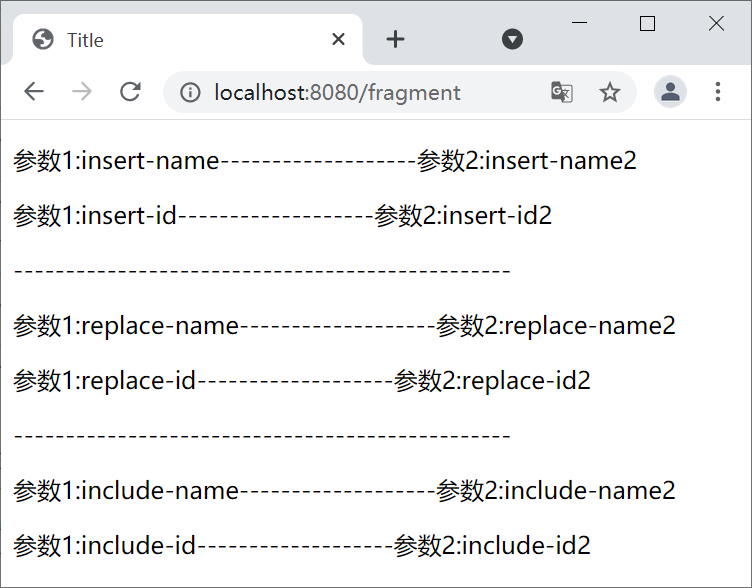Thymeleaf教程(10分钟入门)
Thymeleaf 是一款用于渲染 XML/XHTML/HTML5 内容的模板引擎。它与 JSP,Velocity,FreeMaker 等模板引擎类似,也可以轻易地与 Spring MVC 等 Web 框架集成。与其它模板引擎相比,Thymeleaf 最大的特点是,即使不启动 Web 应用,也可以直接在浏览器中打开并正确显示模板页面 。
1. Thymeleaf 简介
Thymeleaf 是新一代 Java 模板引擎,与 Velocity、FreeMarker 等传统 Java 模板引擎不同,Thymeleaf 支持 HTML 原型,其文件后缀为“.html”,因此它可以直接被浏览器打开,此时浏览器会忽略未定义的 Thymeleaf 标签属性,展示 thymeleaf 模板的静态页面效果;当通过 Web 应用程序访问时,Thymeleaf 会动态地替换掉静态内容,使页面动态显示。
Thymeleaf 通过在 html 标签中,增加额外属性来达到“模板+数据”的展示方式,示例代码如下。
<!DOCTYPE html> <html lang="en" xmlns:th="http://www.thymeleaf.org"> <head> <meta charset="UTF-8"> <title>Title</title> </head> <body> <!--th:text 为 Thymeleaf 属性,用于在展示文本--> <h1 th:text="迎您来到Thymeleaf">欢迎您访问静态页面 HTML</h1> </body> </html>
当直接使用浏览器打开时,浏览器展示结果如下。
欢迎您访问静态页面HTML
当通过 Web 应用程序访问时,浏览器展示结果如下。
迎您来到Thymeleaf
Thymeleaf 的特点
Thymeleaf 模板引擎具有以下特点:- 动静结合:Thymeleaf 既可以直接使用浏览器打开,查看页面的静态效果,也可以通过 Web 应用程序进行访问,查看动态页面效果。
- 开箱即用:Thymeleaf 提供了 Spring 标准方言以及一个与 SpringMVC 完美集成的可选模块,可以快速的实现表单绑定、属性编辑器、国际化等功能。
- 多方言支持:它提供了 Thymeleaf 标准和 Spring 标准两种方言,可以直接套用模板实现 JSTL、 OGNL 表达式;必要时,开发人员也可以扩展和创建自定义的方言。
- 与 SpringBoot 完美整合:SpringBoot 为 Thymeleaf 提供了的默认配置,并且还为 Thymeleaf 设置了视图解析器,因此 Thymeleaf 可以与 Spring Boot 完美整合。
2. Thymeleaf 语法规则
在使用 Thymeleaf 之前,首先要在页面的 html 标签中声明名称空间,示例代码如下。
xmlns:th="http://www.thymeleaf.org"
在 html 标签中声明此名称空间,可避免编辑器出现 html 验证错误,但这一步并非必须进行的,即使我们不声明该命名空间,也不影响 Thymeleaf 的使用。
Thymeleaf 作为一种模板引擎,它拥有自己的语法规则。Thymeleaf 语法分为以下 2 类:
- 标准表达式语法
- th 属性
2.1 标准表达式语法
Thymeleaf 模板引擎支持多种表达式:
- 变量表达式:${...}
- 选择变量表达式:*{...}
- 链接表达式:@{...}
- 国际化表达式:#{...}
- 片段引用表达式:~{...}
2.1.1 变量表达式
使用 ${} 包裹的表达式被称为变量表达式,该表达式具有以下功能:
- 获取对象的属性和方法
- 使用内置的基本对象
- 使用内置的工具对象
① 获取对象的属性和方法
使用变量表达式可以获取对象的属性和方法,例如,获取 person 对象的 lastName 属性,表达式形式如下:
${person.lastName}
② 使用内置的基本对象
使用变量表达式还可以使用内置基本对象,获取内置对象的属性,调用内置对象的方法。 Thymeleaf 中常用的内置基本对象如下:
- #ctx :上下文对象;
- #vars :上下文变量;
- #locale:上下文的语言环境;
- #request:HttpServletRequest 对象(仅在 Web 应用中可用);
- #response:HttpServletResponse 对象(仅在 Web 应用中可用);
- #session:HttpSession 对象(仅在 Web 应用中可用);
- #servletContext:ServletContext 对象(仅在 Web 应用中可用)。
例如,我们通过以下 2 种形式,都可以获取到 session 对象中的 map 属性:
${#session.getAttribute('map')}
${session.map}
③ 使用内置的工具对象
除了能使用内置的基本对象外,变量表达式还可以使用一些内置的工具对象。
- strings:字符串工具对象,常用方法有:equals、equalsIgnoreCase、length、trim、toUpperCase、toLowerCase、indexOf、substring、replace、startsWith、endsWith,contains 和 containsIgnoreCase 等;
- numbers:数字工具对象,常用的方法有:formatDecimal 等;
- bools:布尔工具对象,常用的方法有:isTrue 和 isFalse 等;
- arrays:数组工具对象,常用的方法有:toArray、length、isEmpty、contains 和 containsAll 等;
- lists/sets:List/Set 集合工具对象,常用的方法有:toList、size、isEmpty、contains、containsAll 和 sort 等;
- maps:Map 集合工具对象,常用的方法有:size、isEmpty、containsKey 和 containsValue 等;
- dates:日期工具对象,常用的方法有:format、year、month、hour 和 createNow 等。
例如,我们可以使用内置工具对象 strings 的 equals 方法,来判断字符串与对象的某个属性是否相等,代码如下。
${#strings.equals('编程帮',name)}
2.1.2 选择变量表达式
选择变量表达式与变量表达式功能基本一致,只是在变量表达式的基础上增加了与 th:object 的配合使用。当使用 th:object 存储一个对象后,我们可以在其后代中使用选择变量表达式(*{...})获取该对象中的属性,其中,“*”即代表该对象。
<div th:object="${session.user}" >
<p th:text="*{fisrtName}">firstname</p>
</div>
th:object 用于存储一个临时变量,该变量只在该标签及其后代中有效,在后面的内容“th 属性”中我详细介绍。
2.1.3 链接表达式
不管是静态资源的引用,还是 form 表单的请求,凡是链接都可以用链接表达式 (@{...})。
链接表达式的形式结构如下:
- 无参请求:@{/xxx}
- 有参请求:@{/xxx(k1=v1,k2=v2)}
例如使用链接表达式引入 css 样式表,代码如下。
<link href="asserts/css/signin.css" th:href="@{/asserts/css/signin.css}" rel="stylesheet">
2.1.4 国际化表达式
消息表达式一般用于国际化的场景。结构如下。
th:text="#{msg}"
注意:此处了解即可,我们会在后面的章节中详细介绍。
2.1.5 片段引用表达式
片段引用表达式用于在模板页面中引用其他的模板片段,该表达式支持以下 2 中语法结构:
- 推荐:~{templatename::fragmentname}
- 支持:~{templatename::#id}
以上语法结构说明如下:
- templatename:模版名,Thymeleaf 会根据模版名解析完整路径:/resources/templates/templatename.html,要注意文件的路径。
- fragmentname:片段名,Thymeleaf 通过 th:fragment 声明定义代码块,即:th:fragment="fragmentname"
- id:HTML 的 id 选择器,使用时要在前面加上 # 号,不支持 class 选择器。
2.2 th 属性
Thymeleaf 还提供了大量的 th 属性,这些属性可以直接在 HTML 标签中使用,其中常用 th 属性及其示例如下表。
| 属性 | 描述 | 示例 |
|---|---|---|
| th:id | 替换 HTML 的 id 属性 |
<input id="html-id" th:id="thymeleaf-id" /> |
| th:text | 文本替换,转义特殊字符 |
<h1 th:text="hello,bianchengbang" >hello</h1> |
| th:utext | 文本替换,不转义特殊字符 |
<div th:utext="'<h1>欢迎来到编程帮!</h1>'" >欢迎你</div> |
| th:object |
在父标签选择对象,子标签使用 *{…} 选择表达式选取值。 没有选择对象,那子标签使用选择表达式和 ${…} 变量表达式是一样的效果。 同时即使选择了对象,子标签仍然可以使用变量表达式。 |
<div th:object="${session.user}" >
<p th:text="*{fisrtName}">firstname</p>
</div>
|
| th:value | 替换 value 属性 |
<input th:value = "${user.name}" />
|
| th:with | 局部变量赋值运算 |
<div th:with="isEvens = ${prodStat.count}%2 == 0" th:text="${isEvens}"></div>
|
| th:style | 设置样式 |
<div th:style="'color:#F00; font-weight:bold'">编程帮 www.biancheng.net</div> |
| th:onclick | 点击事件 |
<td th:onclick = "'getInfo()'"></td> |
| th:each |
遍历,支持 Iterable、Map、数组等。 |
<table>
<tr th:each="m:${session.map}">
<td th:text="${m.getKey()}"></td>
<td th:text="${m.getValue()}"></td>
</tr>
</table>
|
| th:if | 根据条件判断是否需要展示此标签 |
<a th:if ="${userId == collect.userId}">
|
| th:unless | 和 th:if 判断相反,满足条件时不显示 |
<div th:unless="${m.getKey()=='name'}" ></div>
|
| th:switch |
与 Java 的 switch case语句类似 通常与 th:case 配合使用,根据不同的条件展示不同的内容 |
<div th:switch="${name}">
<span th:case="a">编程帮</span>
<span th:case="b">www.biancheng.net</span>
</div>
|
| th:fragment | 模板布局,类似 JSP 的 tag,用来定义一段被引用或包含的模板片段 |
<footer th:fragment="footer">插入的内容</footer> |
| th:insert |
布局标签; 将使用 th:fragment 属性指定的模板片段(包含标签)插入到当前标签中。 |
<div th:insert="commons/bar::footer"></div> |
| th:replace |
布局标签; 使用 th:fragment 属性指定的模板片段(包含标签)替换当前整个标签。 |
<div th:replace="commons/bar::footer"></div> |
| th:selected | select 选择框选中 |
<select>
<option>---</option>
<option th:selected="${name=='a'}">
编程帮
</option>
<option th:selected="${name=='b'}">
www.biancheng.net
</option>
</select>
|
| th:src | 替换 HTML 中的 src 属性 |
<img th:src="@{/asserts/img/bootstrap-solid.svg}" src="asserts/img/bootstrap-solid.svg" />
|
| th:inline |
内联属性; 该属性有 text、none、javascript 三种取值, 在 <script> 标签中使用时,js 代码中可以获取到后台传递页面的对象。 |
<script type="text/javascript" th:inline="javascript">
var name = /*[[${name}]]*/ 'bianchengbang';
alert(name)
</script>
|
| th:action | 替换表单提交地址 |
<form th:action="@{/user/login}" th:method="post"></form>
|
3. Thymeleaf 公共页面抽取
在 Web 项目中,通常会存在一些公共页面片段(重复代码),例如头部导航栏、侧边菜单栏和公共的 js css 等。我们一般会把这些公共页面片段抽取出来,存放在一个独立的页面中,然后再由其他页面根据需要进行引用,这样可以消除代码重复,使页面更加简洁。3.1 抽取公共页面
Thymeleaf 作为一种优雅且高度可维护的模板引擎,同样支持公共页面的抽取和引用。我们可以将公共页面片段抽取出来,存放到一个独立的页面中,并使用 Thymeleaf 提供的 th:fragment 属性为这些抽取出来的公共页面片段命名。示例 1
将公共页面片段抽取出来,存放在 commons.html 中,代码如下。
<div th:fragment="fragment-name" id="fragment-id">
<span>公共页面片段</span>
</div>
3.2 引用公共页面
在 Thymeleaf 中,我们可以使用以下 3 个属性,将公共页面片段引入到当前页面中。- th:insert:将代码块片段整个插入到使用了 th:insert 属性的 HTML 标签中;
- th:replace:将代码块片段整个替换使用了 th:replace 属性的 HTML 标签中;
- th:include:将代码块片段包含的内容插入到使用了 th:include 属性的 HTML 标签中。
使用上 3 个属性引入页面片段,都可以通过以下 2 种方式实现。
- ~{templatename::selector}:模板名::选择器
- ~{templatename::fragmentname}:模板名::片段名
通常情况下,~{} 可以省略,其行内写法为 [[~{...}]] 或 [(~{...})],其中 [[~{...}]] 会转义特殊字符,[(~{...})] 则不会转义特殊字符。
示例 2
1. 在页面 fragment.html 中引入 commons.html 中声明的页面片段,可以通过以下方式实现。<!--th:insert 片段名引入--> <div th:insert="commons::fragment-name"></div> <!--th:insert id 选择器引入--> <div th:insert="commons::#fragment-id"></div> ------------------------------------------------ <!--th:replace 片段名引入--> <div th:replace="commons::fragment-name"></div> <!--th:replace id 选择器引入--> <div th:replace="commons::#fragment-id"></div> ------------------------------------------------ <!--th:include 片段名引入--> <div th:include="commons::fragment-name"></div> <!--th:include id 选择器引入--> <div th:include="commons::#fragment-id"></div>
2. 启动 Spring Boot,使用浏览器访问 fragment.html,查看源码,结果如下。
<!--th:insert 片段名引入-->
<div>
<div id="fragment-id">
<span>公共页面片段</span>
</div>
</div>
<!--th:insert id 选择器引入-->
<div>
<div id="fragment-id">
<span>公共页面片段</span>
</div>
</div>
------------------------------------------------
<!--th:replace 片段名引入-->
<div id="fragment-id">
<span>公共页面片段</span>
</div>
<!--th:replace id 选择器引入-->
<div id="fragment-id">
<span>公共页面片段</span>
</div>
------------------------------------------------
<!--th:include 片段名引入-->
<div>
<span>公共页面片段</span>
</div>
<!--th:include id 选择器引入-->
<div>
<span>公共页面片段</span>
</div>
3.3 传递参数
Thymeleaf 在抽取和引入公共页面片段时,还可以进行参数传递,大致步骤如下:- 传入参数;
- 使用参数。
3.3.1 传入参数
引用公共页面片段时,我们可以通过以下 2 种方式,将参数传入到被引用的页面片段中:- 模板名::选择器名或片段名(参数1=参数值1,参数2=参数值2)
- 模板名::选择器名或片段名(参数值1,参数值2)
示例代码如下:注:
- 若传入参数较少时,一般采用第二种方式,直接将参数值传入页面片段中;
- 若参数较多时,建议使用第一种方式,明确指定参数名和参数值,。
<!--th:insert 片段名引入--> <div th:insert="commons::fragment-name(var1='insert-name',var2='insert-name2')"></div> <!--th:insert id 选择器引入--> <div th:insert="commons::#fragment-id(var1='insert-id',var2='insert-id2')"></div> ------------------------------------------------ <!--th:replace 片段名引入--> <div th:replace="commons::fragment-name(var1='replace-name',var2='replace-name2')"></div> <!--th:replace id 选择器引入--> <div th:replace="commons::#fragment-id(var1='replace-id',var2='replace-id2')"></div> ------------------------------------------------ <!--th:include 片段名引入--> <div th:include="commons::fragment-name(var1='include-name',var2='include-name2')"></div> <!--th:include id 选择器引入--> <div th:include="commons::#fragment-id(var1='include-id',var2='include-id2')"></div>
3.3.2 使用参数
在声明页面片段时,我们可以在片段中声明并使用这些参数,例如:
<!--使用 var1 和 var2 声明传入的参数,并在该片段中直接使用这些参数 -->
<div th:fragment="fragment-name(var1,var2)" id="fragment-id">
<p th:text="'参数1:'+${var1} + '-------------------参数2:' + ${var2}">...</p>
</div>
启动 Spring Boot,使用浏览器访问 fragment.html,结果如下图。

图1:参数传递效果图
